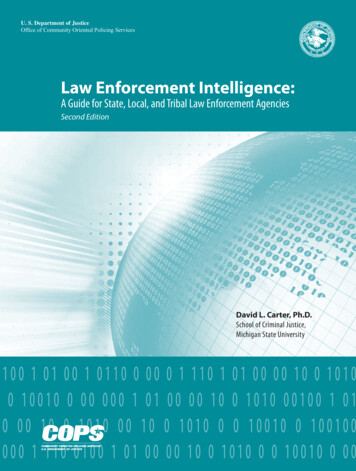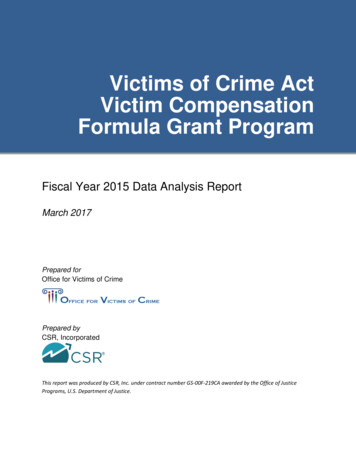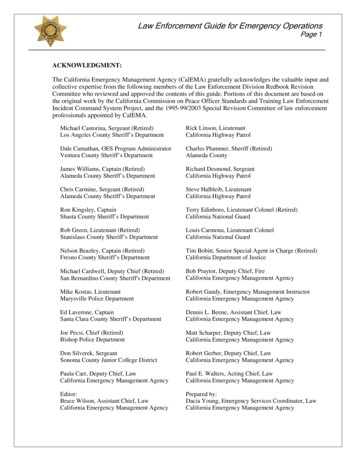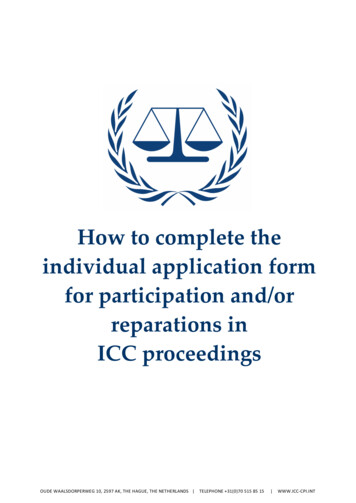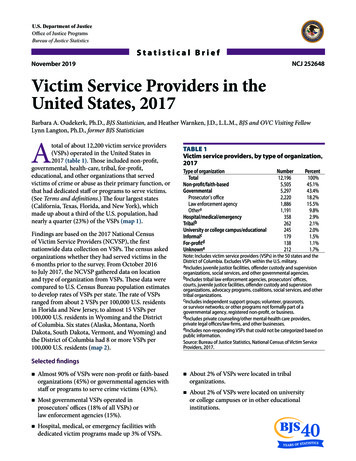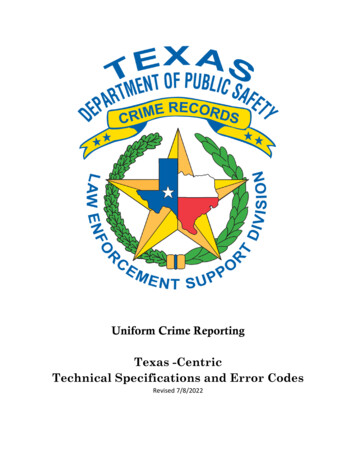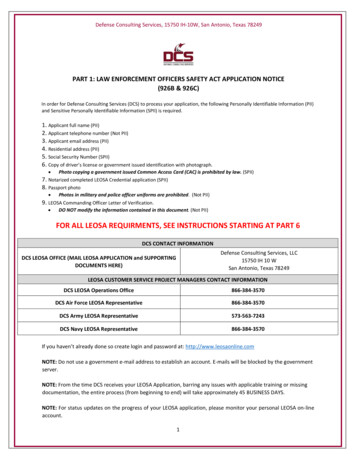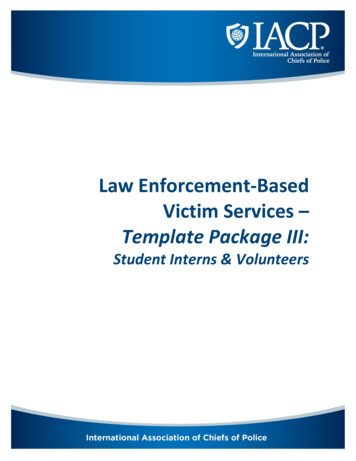
Transcription
Law Enforcement-BasedVictim Services –Template Package III:Student Interns & Volunteers
Law Enforcement-Based Victim Services—Template Package IIITABLE OF CONTENTSIntroduction . 4Prior Publications & Accompanying Webinars . 4Explanation of Templates . 5Definitions . 6Student Intern and Volunteer Programs . 7Program Development. 8Supervisor Selection . 8Grant Funding . 9Clarification of Responsibilities . 9Recruiting . 10Framing the Message and Timing . 11Screening and Selection . 12Application . 12Background . 13Interview . 13References . 15Selection Decision . 15Administrative Considerations. 15Rights and Responsibilities . 15Liability and Risk. 16Equipment. 17Training . 17Orientation . 17Onboarding . 18Revised July 20222
Law Enforcement-Based Victim Services—Template Package IIIOngoing Training . 19Supervision and Evaluation . 20Individual Supervision and Evaluation . 20Program Evaluation. 20TemplatesStudent Intern/Volunteer Recruiting Pamphlet . 23Student Intern/Volunteer Media Release. 24Student Intern/Volunteer Application . 25Student Intern/Volunteer Interview Questions . 26Student Intern/Volunteer Reference Questions. 28Student Intern/Volunteer Deselection Notification . 29Student Intern/Volunteer Selection Notification . 30Student Intern/Volunteer File Cover Sheet . 31Student Intern/Volunteer Rights and Responsibilities Statement . 32Student Intern/Volunteer Personal Injury & Property Coverage . 35Student Intern/Volunteer Property Use and Return Agreement . 36Student Intern/Volunteer Law Enforcement Contact Report . 37Student Intern/Volunteer Onboarding Checklist . 38Student Intern/Volunteer Peer/Partner Learning Opportunity Feedback . 41Student Intern/Volunteer Supervision Notes . 42This publication was developed by the International Association of Chiefs of Police (IACP) under 2018-V3-GX-K049, awarded bythe Office for Victims of Crime, Office of Justice Programs, U.S. Department of Justice. The opinions, findings, and conclusions orrecommendations expressed in this publication are those of the contributors and do not necessarily represent the official positionof the U.S. Department of Justice.Revised July 20223
Law Enforcement-Based Victim Services—Template Package IIIIntroductionVictim-centered responses and services are vital to the safety, stability, and healing of crime victims, astheir use can ultimately reduce and prevent future victimization.1 In 2018, to support the development oflaw enforcement-based victim services in the United States, to strengthen their capacity, and to supportpartnerships with community-based programs, the U.S. Department of Justice, Office for Victims of Crime(OVC) launched the Law Enforcement-Based Victim Services & Technical Assistance Program (LEVProgram). Providing training and technical assistance for the LEV Program, the International Associationof Chiefs of Police (IACP) aims to enhance the capacity of law enforcement-based victim services byproviding guidance on promising practices, protocols, and policies to support victims’ access to their legalrights and the services and responses they need.The IACP is committed to shaping the future of the police profession. Through timely research,programming, and unparalleled training opportunities, the IACP is preparing current and emerging policeleaders—and the agencies and communities they serve—to succeed in addressing the most pressingissues, threats, and challenges of the day.Prior Publications & Accompanying WebinarsThe LEV Program aims to guide agencies to provide high-quality services (coordinated, collaborative,culturally responsive, multidisciplinary, and trauma-informed) that address the broader needs and rightsof all crime victims. The following publications can assist in these efforts. Establishing or Enhancing Law Enforcement-Based Victim Services—What Are the KeyConsiderations? and the accompanying Key Considerations Checklist provide guidance to agenciesestablishing or enhancing services to victims. These publications include an overview offoundational topics for law enforcement-based victim services.1 Victims’ Rights Jurisdiction Profiles provide state-specific information on the intersections ofvictims’ rights and communication with victim services personnel. Establishing or Enhancing Law Enforcement-Based Victim Services – Advocacy Parametersdiscusses the structure of law enforcement-based victim services, personnel supervision, andservice delivery. Establishing or Enhancing Law Enforcement-Based Victim Services – Documentation Standardsdiscusses victim services documentation location, content, access, and legal intersections. Establishing or Enhancing Law Enforcement-Based Victim Services – Effective Partnershipsdiscusses the benefits of partnerships and encourages agencies to consider both internal andexternal partners to strengthen community response to victims.Brian A. Reaves, Police Response to Domestic Violence, 2006–2015 (Washington, DC: Bureau of Justice Statistics, 2017).Revised July 20224
Law Enforcement-Based Victim Services—Template Package III Establishing or Enhancing Law Enforcement-Based Victim Services – Using Technology toCommunicate with Victims discusses considerations when using virtual technology tocommunicate with victims.To supplement the publications, IACP developed a virtual training series, which is accessible through theLEV webpage. Each topic covered has content intended for sworn personnel and content intended forprogram personnel. This model promotes a thorough understanding of the intricacies of victim servicesat all levels of a law enforcement agency.Explanation of TemplatesWhether establishing or enhancing law enforcement-based victim services programs, creating policiesand standards for victim services personnel and service delivery is critical. This document providestemplates to serve as a starting point for agencies, but this compilation is not an exhaustive list ofresources for creating victim services policies or procedures. These templates were developed through areview of documents from existing law enforcement-based victim services programs.They are intended to provide sample language and content to assess, develop, and refine program andprofessional victim service standards within agencies. These templates should be customized to fit anagency’s standard procedure in format, language, and intent. All templates should be carefully reviewedto ensure information is consistent with agency, statutory, and constitutional requirements within thelocal jurisdiction and reviewed by human resources and legal counsel. This document, Template PackageIII: Student Interns & Volunteers, focuses on topics such as recruiting, screening and selection, training,supervision, and other agency considerations for these personnel.This is the third document of the Template Package series. The following template packages have beenpublished — Template Package I: Getting Started provides victim services personnel job descriptions, interviewquestions, code of ethics, and personnel standards and responsibilities. Template Package II: Next Steps provides case response protocol templates, scenarios, anddocumentation samples. Template Package IV: Pamphlets includes sample crime-specific and topic-specific informationalpamphlets for agencies to customize and disseminate to victims of crime. Template Package V: Training includes customizable presentations and activity workbooksagencies can use for victim services personnel training.Revised July 20225
Law Enforcement-Based Victim Services—Template Package IIIDefinitionsThroughout this document series, the following definitions will apply. They were selected through areview of documents in the field including those from existing law enforcement-based victim servicesprograms:Throughout this document series, the following definitions will apply:23 Agency—refers to the police department, sheriff’s office, tribal police or public safetydepartment, campus police department, district attorney’s office, state attorney’s office, or othergovernmental criminal justice entity that is employing victim services personnel. Spontaneous Disclosure—situations in which a victim, witness, survivor, or co-victim,unprompted, discloses details about criminal events to victim services personnel that were notpreviously shared with law enforcement personnel. Student Intern—someone who serves in an agency for a designated period with or withoutpromise, expectation, or receipt of compensation for services rendered and is affiliated with aninstitution of higher education.2 Vicarious Trauma—emotional and psychological cost to people working and volunteering in lawenforcement, victim services, emergency medical services, fire services, and other alliedprofessions due to exposure to victims of trauma and violence; related terms include compassionfatigue and secondary traumatic stress.3 Victim Services Personnel—personnel (paid or unpaid) designated to provide law enforcementbased program oversight, crisis intervention, criminal justice support, community referrals andadvocacy on behalf of crime victims, witnesses, survivors, and co-victims. Victim Services Unit (VSU)—the unit within the law enforcement agency that houses the victimservices personnel. Victim, Witness, Survivor, Co-victim—any person (minor or adult) who directly experiences or isimpacted by a crime or criminal activity.oVictim is an individual who is an independent participant in the criminal case underfederal or state victims’ rights laws, denotes a person’s legal status (unavailable to thegeneral public), and defines the level and extent of participation that the individual isentitled to in the criminal matter.oWitness is an individual who has personal knowledge of information or actions that arerelative to the incident being investigated.International Association of Chiefs of Police (IACP) Law Enforcement Policy Center, Concepts & Issues Paper: Volunteers (Alexandria, VA: 2019).Office for Victims of Crime, “Glossary of Terms” in The Vicarious Trauma Toolkit.Revised July 20226
Law Enforcement-Based Victim Services—Template Package III oSurvivor is often used interchangeably with “victim” when conveying context related toresilience and healing.oCo-victim is an individual who has lost a loved one to homicide, including family members,other relatives, and friends of the decedent.Volunteer—someone who performs a service for an agency without promise, expectation, orreceipt of compensation for services rendered.4Student Intern and Volunteer ProgramsStudent interns and volunteers can add considerable value to law enforcement-based victim servicesprograms, law enforcement agencies, and the communities they serve. They can bring new energy andenthusiasm and contribute as force multipliers to expand the scope of services to victims. They can takeon projects that might not be prioritized due to time constraints but may have a significant impact. Theycan gain a better understanding of the agency and the policing profession. Like hiring a diverse staff,student interns and volunteers from diverse backgrounds can serve as ambassadors for identifiedpopulations and provide valuable feedback to the agency.5 This can help strengthen relationships betweenthe agency and community. Additionally, through strong training and experience, student interns andvolunteers may become viable candidates for paid positions in the future.Agencies starting student intern and volunteer programs are encouraged to set high standards forparticipants that align with the agency’s mission, vision, and values. While some agencies may be inclinedto accept all individuals who inquire about student intern and volunteer opportunities, recognizing thatnot everyone is suited to participate in law enforcement settings or for certain tasks is important. Someroles require specialized skills and training. The quality of student interns and volunteers can add to ordetract from victim services program and agency integrity.Agencies should consider the potential impact of employment and the institutional affiliation status ofstudent interns and volunteers. For example, paid student interns may be entitled to certain rights,benefits, and responsibilities as employees of the agency while unpaid interns and volunteers generallyare not. Additionally, student interns often must meet requirements from both the educationalinstitutions with which they are affiliated and agencies where they are placed. Joint oversight plans andopen lines of communication that detail clear expectations are essential. Decisions regarding employmentand institutional affiliation status can impact the quality of applicants the agency receives for thesepositions, assigned responsibilities of student interns and volunteers, the level of agency responsibility tostudent interns and volunteers, and risk to the agency.While student interns and volunteers can add value to agencies and enhance services to victims, ensuringthese opportunities carry value for the individuals is important. Agencies are encouraged to develop and45IACP Law Enforcement Policy Center, Concepts & Issues Paper: Volunteers.IACP, Concepts & Issues Paper: Volunteers, 1.Revised July 20227
Law Enforcement-Based Victim Services—Template Package IIIidentify responsibilities that are meaningful and contribute to the agency’s mission, vision, and values.Effective training and supervision of student interns and volunteers can also help sustain mutuallybeneficial programs.Program DevelopmentAgency leaders should be aware of the investment required to establish solid student intern and volunteerprograms and strategically plan for program inception, development, maintenance, and growth. Whilemany agencies look to student interns and volunteers to add workforce capacity with limited financialinvestment, it is important to establish these programs with clear goals in mind. Agencies are encouragedto conduct cost-benefit analyses when determining the scope and structure of student intern andvolunteer programs. The effort to launch student intern and volunteer programs is similar to establishingvictim services programs, in that policies must be written, qualifications established, and processescreated for recruiting, selection, training, supervision, and evaluation. Agencies are encouraged to startsmall and build over time. Agencies should be prepared to gather and track program data (e.g., numberof student interns and volunteers, number of hours of service provided, associated costs for supplies anduniforms) from the outset. Ensuring that baseline and ongoing data are consistently captured can helpagencies measure the growth, impact, and value of these programs. Incorporating this information intoroutine reviews of victim services program and overall agency data can also help identify new agencyneeds and gaps in services that may be filled by student interns and volunteers. While a considerableinvestment of time and resources is required to establish these programs, the benefits can be farreaching.Supervisor SelectionIdentifying the personnel who will oversee the programs is one of the most important decisions whendeveloping student intern and volunteer programs. While student interns and volunteers are oftenvaluable assets in support of victim services personnel and quality service delivery, personnel time will berequired for specialized training and meaningful oversight.Agencies should assess the specialized skills and capacity of individuals responsible for establishing andoverseeing student intern and volunteer programs. Personnel selected to oversee student interns andvolunteers must have dedicated time, skill sets, and training to effectively motivate, train, and manageprogram participants. The current workload of personnel overseeing these programs should be taken intoconsideration and modified if needed. For example, a victim services unit supervisor tasked withestablishing a student intern and volunteer program should plan a strategic and realistic timeline toensure capacity is built deliberately, effectively, and sustainably. Many tasks completed while building theoverall victim services program, including policy development, training plans, and personnel managementcan be easily adapted with future student intern and volunteer programs in mind.Agencies must be familiar with supervision requirements for student interns. For interns to receiveacademic credit, supervisors are often required to have a graduate level degree and, for some programs,licensure in a behavioral health discipline. Agencies may be eligible to receive interns from theseRevised July 20228
Law Enforcement-Based Victim Services—Template Package IIIeducational programs by selecting sworn and professional supervisors who have the required degrees orlicensure. Demonstration of mutual benefit for the agency and the student intern through a learningcontract is another common requirement. Agencies need to plan for realistic time commitments tooversee learning objectives, assigned tasks, and required evaluations for student interns.Grant FundingAgencies who pursue grant funding to support victim services programs should be aware that some grantfunding requires the use of volunteers. Incorporating student interns may also help agencies meet thisrequirement. There may also be requirements around service provision for specific victimizationcategories. For example, some grant funding prohibits use of funds for activities associated with noncriminal events (e.g., response to suicide, non-criminal traffic events). Agencies using grant funding shouldalso be aware of the possible limitations on using grant funds for student intern and volunteermanagement duties, guidelines for determining the monetary value of work completed by participants,and programmatic and financial reporting requirements. Agencies must ensure student intern andvolunteer expectations align with funding requirements that support the programs.Clarification of ResponsibilitiesAgencies are encouraged to consider responsibilities that will benefit both the agency and student internsand volunteers. Developing position descriptions that accurately describe roles, assigned responsibilities,and minimum requirements (e.g., age, ability to pass a background check, access to reliabletransportation, time commitments) for student interns and volunteers can establish a solid foundationfor selection processes. Position descriptions can also be used to evaluate whether student interns andvolunteers are meeting program and agency expectations. Position descriptions should be reviewedand regularly updated to accurately reflect program goals, student intern and volunteer responsibilities,and agency policies.6Student interns and volunteers can contribute to agencies through a variety of responsibilities, including—Direct services to victimsProgram development phone and/or office contactfield responseon-call responseresource development policy/protocol development and updating research on funding options drafting proposals (e.g., grants, budget)6See sample position descriptions for student interns and volunteers in Law Enforcement-Based Victim Services: TemplatePackage I – Getting Started.Revised July 20229
Law Enforcement-Based Victim Services—Template Package IIICommunity engagementTechnologyAdministrative assistance event planningvolunteer recruitmentevent staffing/participationeducation institution contact data system development social media content development webpage development answering phonesdata trackingclerical/office supporttraining preparationAgencies can utilize student interns and volunteers in a variety of ways and should be open to expandingassigned responsibilities over time. Depending on funding requirements, agencies may choose to begintheir programs with student interns and volunteers working in administrative capacities with the goal ofexpanding to include direct services to victims in the future. For example, a student studying mathematicsor statistics may be well-suited for data analysis during initial program implementation. Agencies shoulddevelop policies and protocols specifically for student interns and volunteers that complement existingvictim services and agency policies and protocols.RecruitingInvesting in the recruiting process on the front end is a worthwhile endeavor and can result in strong,sustainable student intern and volunteer programs. Agencies are encouraged to actively and strategicallyseek individuals who are qualified for specific responsibilities and represent the diversity of thecommunity. Agencies can begin by carefully assessing the needs of the program. For example, volunteersto answer and direct calls may need strong administrative and community referral backgrounds, whilethese skills might not be required for volunteers to prepare pamphlets and basic needs kits for victims.Agencies are encouraged to identify community agencies and groups with access to potential volunteers.Some groups may include retired or older adults, stay at home parents with children in school,college/university students, high school students, individuals from diverse backgrounds that reflect thecommunity served, individuals with proficiency in another language as well as English, faith-basedorganizations, and service organizations. When recruiting student interns, agencies can start byidentifying the institutions of higher education (e.g., colleges, universities, community colleges, onlineprograms) in or near the community. Contact with those who offer degrees in victim services, social work,counseling, psychology, criminal justice administration, business administration, information technology,statistics, and research may be beneficial. Student organizations or specific campus communities (e.g.,Latinx student leaders, Chinese student clubs) can also be avenues for recruitment.Revised July 202210
Law Enforcement-Based Victim Services—Template Package IIIAgencies are encouraged to tap into existing programs, student interns, and volunteers to assist withrecruiting efforts. Current personnel and participants are often highly invested and eager to both expandthe program and share the agency’s desire to maintain the integrity of the program. Agencies can alsolook to the graduates of their citizen police academies and other similar programs for potential studentinterns and volunteers. Word-of-mouth can be one of the most effective methods of recruitment.Framing the Message and TimingMessages developed around recruitment efforts are vital to attracting qualified student interns andvolunteers. Messages should convey both the reason the agency is seeking applicants and a sense ofurgency. For example, an agency wishing to supplement the Victim Services Unit’s response to victims inan on-call capacity may consider including statistics about victims currently served and additional victimsthat could be served with new volunteers. This shows both the crucial need and the value volunteers canadd. For maximum impact, agencies are also encouraged to include information about how the studentintern or volunteer opportunity can benefit participants and tailor messages to specific groups. Forexample, the message for inviting high school students to hand out water at an outdoor community eventmay focus on giving back to the community and working side-by-side with agency personnel. Meanwhile,the message encouraging university students to apply for an internship related to data collection andevaluation may focus on earning school credit and presenting findings to agency leadership.Agencies must determine how often student intern and volunteer recruitment activities will occur. Thiswill largely depend on the identified responsibilities of the student interns and volunteers. Recruitmentschedules for student interns are often tied to academic calendars, but some schools allow students tobegin internships mid-semester and/or during the summer months when classes are not in session.Agencies should determine when recruitment for student interns is recommended by the identified highereducation institutions, as some recruitment and interview processes take place 4-6 months before theinternship starts. Student interns and volunteers for direct services to victims may be recruited on acontinual or frequent basis to ensure a constant pool of trained, active volunteers. However, recruitingvolunteers for community events may need to occur only once a year.It is best to advertise widely using a variety of methods to maximize the pool of potential student internand volunteer applicants. Different types of advertising and outreach have advantages and limitations.For example, an agency may choose to take part in a local community-wide volunteer fair over a regionalvolunteer fair to attract volunteers who can participate in local events. Additionally, exclusively onlinebased recruiting will eliminate potential student interns and volunteers without access to a computer orinternet. Some advertising options include—OnlineRevised July 2022 Local non-profit or corporate agency volunteer interest boardsOnline job or volunteer websites (e.g., Idealist, Indeed, VolunteerMatch)Social media platforms (agency, partner agencies, colleges, universities)Agency webpage11
Law Enforcement-Based Victim Services—Template Package IIITelevision/radioIn-person/word ofmouthPrint Story or segment profiling agency student intern and volu
Revised July 2022 5 Law Enforcement-Based Victim Services—Template Package III Establishing or Enhancing Law Enforcement-Based Victim Services - Using Technology to Communicate with Victims discusses considerations when using virtual technology to communicate with victims. To supplement the publications, IACP developed a virtual training series, which is accessible through the
